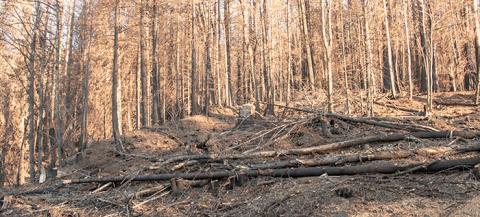It’s spring! Time to think about wildlife in burned areas
May 04, 2021
Wildfire in Oregon elicits powerful responses from all walks of life, whether it’s from concerned citizens, landowners, firefighters or others. In September 2020, Oregon faced a series of catastrophic wildfires that burned approximately 1 million acres. Federal, state and private lands were impacted. Causes are being investigated, and although I understand there are many considerations, the sustained winds and drought conditions meant that regardless of ownership or management, most everything within the pathway of these fires burned. My heart still hurts for all the loss, even though the fires were months ago. The loss of life, of homes and other structures, of timber, and of wildlife and wildlife habitat – these losses will be felt for generations. We’re all looking for ways we can help.
Conversations with the Oregon Department of Fish and Wildlife (ODFW) staff have given me hope that most of the wildlife that live in Oregon’s forests survived these fires. Some were able to directly escape, while others sheltered in place by burrowing deep into the soil or finding unburned areas such as streams and lakes to hunker down. However, a million acres is a lot of burned area that’s not providing the same food sources for wildlife that it once did, for the time being.
There are many “after-the-fire” actions forest landowners can implement, and we recommend visiting fire-resource websites specifically designed to help landowners. Here are two great sites:
https://extension.oregonstate.edu/forests/fire
It’s important to note that specific actions for wildlife are not always included in suggestions for how to restore forests after wildfire. One simple action landowners can do is to spread a wildlife-friendly seed mix in burned areas. A seed mix will have several benefits. It can help combat invasive species, provide erosion control and offer forage opportunities for wildlife. It can be tough to decide between using a native or non-native mix; we recommend native. If you choose to go with a non-native variety, plant a mix that’s not invasive and will be outcompeted by native vegetation within a few years. Good places to spread seed mix include on fire lines and fire access roadside edges, within burned stands, along riparian areas and slopes leading to riparian areas, and on landings after salvage logging operations are complete. Seed can be spread by hand, from a drone or helicopter, or by hydroseeding. Partner opportunities may be available from ODFW, the Oregon Watershed Enhancement Board or others.
Spring is a great time to plant the seed mixes. The winter was tough for a lot of wildlife, but firsthand reports from the fire line indicate there’s a lot of new growth already coming up. Applying a seed mix is our way of being intentional about what forage will be available for wildlife.
For specific details on where to find seed mixes, what should be in the mix, and how to apply them, check out the Oregon Forest Resources Institute’s new “Seed mixes for wildlife” fact sheet here.
For more information on helping wildlife after wildfire, please contact me directly at fran@cafferataconsulting.com or visit the following websites:
https://www.oregon.gov/ODF/Fire/Pages/AfterAFire.aspx
https://www.nrcs.usda.gov/wps/portal/nrcs/site/or/home/
Fran Cafferata Coe, CWB®
Contract Wildlife Biologist
Oregon Forest Resources Institute
